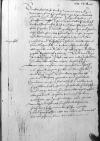List #5021
Albrecht I von Hohenzollern-Ansbach do Ioannes DANTISCUSKönigsberg (Królewiec), 1541-03-30
| odebrano Heilsberg (Lidzbark Warmiński), 1541-03-31 Rękopiśmienne podstawy źródłowe:
Publikacje:
| ||||||||
Tekst + aparat krytyczny + komentarz Zwykły tekst Tekst + komentarz Tekst + aparat krytyczny
Dem erwirdigenn in Got unnserm besonndern liebenn freundt unnd nachbarnn herrenn
Unnsere freuntliche dienst und was wir liebs und guts vermogenn, / zuvor.
Erwirdiger in Got besonnder lieber freundt unnd nachpar. /
Inligende habenn E(uer) L(ieb) zuersehenn mit wasser instruction unnd beveleh der durchleuchtig grosmechtig furst unnd herre, / her
So bittenn wir gancz freuntlich, / E(uer) L(ieb) wollen unns zu gefallenn diese instruction so eÿlende zu ubersehen, / unnd wes ir darine zu endern ader bessern gefelt oder gutdunckt, / dasselbig unns mitzutheilenn / unbeschwert sein. / Inn sonnderheit aber, / wo was vonn kegenwurffenn uff furfallende disputation, / zuerhaltung hochgenenter  BCz, 1606, p. 570 sampt widersendung dieser instruction, / dann wir solchs alles dem koniglichenn gesandten ins furderlichste nachzuschickennn, / irenn rath unnd gutbedunck(en) schrifftlich(en) zufertigenn. Das seindt wir umb dieselb E(uer) L(ieb) zuverder umb hidden by binding⌈[b]b hidden by binding⌉ freuntlichen zuvordienen urbutig. /
BCz, 1606, p. 570 sampt widersendung dieser instruction, / dann wir solchs alles dem koniglichenn gesandten ins furderlichste nachzuschickennn, / irenn rath unnd gutbedunck(en) schrifftlich(en) zufertigenn. Das seindt wir umb dieselb E(uer) L(ieb) zuverder umb hidden by binding⌈[b]b hidden by binding⌉ freuntlichen zuvordienen urbutig. /
Dat(um)
Von Gots gnaden


